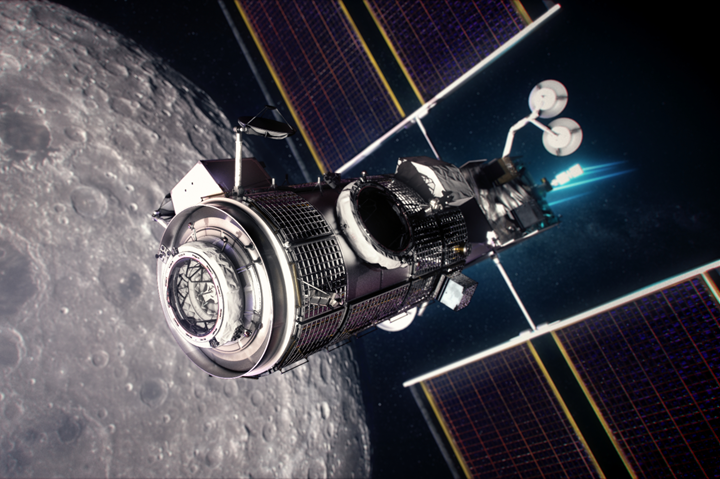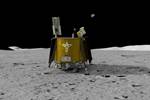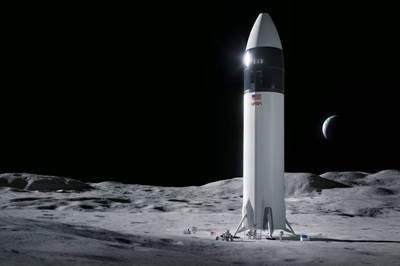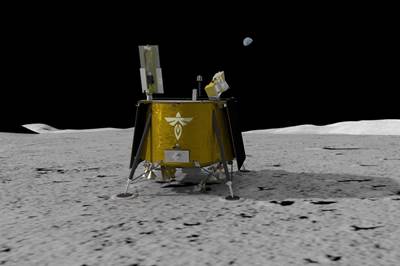NASA, Northrop Grumman finalize moon outpost living quarters contract
The habitation and logistics outpost (HALO), a critical components to the way station Gateway, will be assembled using a monolithic composite structure and aluminum honeycomb panels.

Illustration showing a close-up of the habitation and logistics outpost (HALO), one of the elements of Gateway. Photo Credit: NASA
NASA and Northrop Grumman (Dulles, Va., U.S.) have finalized a contract to develop the habitation and logistics outpost (HALO) for Gateway, which will reportedly be a critical way station and outpost in orbit around the moon as part of NASA’s Artemis program, and will be assembled in lunar orbit. Northrop tells CW that HALO will be using a monolithic composite structure for the inter-element adapter (IEA), and aluminum honeycomb panels for the IEA radiators.
NASA and its commercial and international partners are building Gateway to support science investigations and enable surface landings on the moon, which will help prepare astronauts for future missions to Mars.
The firm, fixed-price contract is valued at $935 million, NASA reports. Under the contract, Northrop Grumman will be responsible for attaching and testing the integrated HALO with the power and propulsion element (PPE) — a high-power, 50-kilowatt (kW) solar electric propulsion spacecraft — being built by Maxar Technologies (Westminster, Colo., U.S.). Northrop Grumman will also lead the integrated PPE and HALO spacecraft turnover and launch preparation with SpaceX (Hawthorne, Calif., U.S.), and support activation and checkout of HALO during the flight to lunar orbit. NASA is targeting November 2024 to launch the integrated spacecraft on a SpaceX Falcon Heavy rocket.
“NASA is building the infrastructure to expand human exploration further out into the solar system than ever before, including Gateway, the lunar space station that will help us make inspirational scientific discoveries at and around the moon. Just as importantly, these investments will help NASA carry out the U.S.’ horizon goal: to further develop and test the technology and science needed for a human trip to Mars,” says NASA Administrator Bill Nelson. “The HALO is a critical component of Gateway, and this announcement brings us one step closer to landing U.S. boots on both the moon and Mars.”
HALO leverages contributions from the Gateway international partners for robust capabilities.
HALO is where astronauts will live and conduct research while visiting the Gateway. The pressurized living quarters will provide command and control systems for the lunar outpost, and docking ports for visiting spacecraft, such as NASA’s Orion spacecraft, lunar landers and logistics resupply craft. The HALO module will serve as the backbone for command and control and power distribution across Gateway and will perform other core functions, including hosting science investigations via internal and external payload accommodations and communicating with lunar surface expeditions. HALO will also enable the aggregation of additional habitable elements to expand Gateway capabilities. Immediately after launch, the Heliophysics Environmental and Radiation Measurement Experiment Suite payload, built by NASA’s Goddard Space Flight Center in Greenbelt, Md, U.S., will begin conducting research outside of the integrated spacecraft.
“This is a major step on the path for Artemis, not just for NASA, but for the combined team, including our commercial and international partners,” says Kathy Lueders, NASA associate administrator for human explorations and operations. “Gateway will provide unprecedented access to the moon and symbolizes the expansion of our partnerships into deep space.”
The integrated PPE and HALO will reportedly be the Gateway’s foundation, enabling humanity’s first permanent outpost in orbit around the moon. Located tens of thousands of miles from the lunar surface at its farthest point and within easy range of lunar landers at its closest, the Gateway will be in a near-rectilinear halo orbit. This orbit will allow NASA and its international and commercial partners to conduct deep space science and technology investigations, and conduct sustainable lunar exploration.
HALO leverages contributions from the Gateway international partners for robust capabilities. Batteries provided by the Japan Aerospace Exploration Agency (JAXA, Tokyo, Japan) will power HALO until PPE solar arrays can be deployed and during eclipse periods. Robotic interfaces provided by the Canadian Space Agency will host payloads and provide base points for Canadarm3 robotic operations. The European Space Agency (ESA) will provide a lunar communications system to enable high-data-rate communications between the lunar surface and Gateway. With three docking ports, HALO will be the hub for international Gateway expansion in the future, including an international habitat that ESA and JAXA will provide, and an ESA-provided refueling module. The docking ports will also host a human landing system for lunar surface expeditions and logistics resupply spacecraft. As the Gateway hub, HALO will provide power, data, airflow to each of these ports, as well as thermal conditioning to assist future elements and spacecraft in controlling the temperature of their equipment and habitable environment.
“Leveraging our success with our Cygnus spacecraft, Northrop Grumman is perfectly positioned to deliver the HALO module, a critical piece for NASA’s Artemis program and our journey to the moon and beyond,” says Frank DeMauro, vice president and general manager for tactical space systems at Northrop Grumman. “After recently completing a successful preliminary design review, we now look forward to completing the detailed design efforts and eventually bringing HALO to life in our Gilbert, Ariz, facility while also providing integration services for the final, combined vehicle before launch.”
HALO’s design is based on Northrop Grumman’s Cygnus spacecraft, which has completed 15 resupply missions to the International Space Station (ISS) to date. A previous contract for HALO, awarded in June 2020, funded work through preliminary design review, one of a series of checkpoints for the complex engineering project. The review process for the module, completed in May, assessed all of the spacecraft’s design to ensure the overall system is safe and reliable for flight and meets NASA’s mission requirements.
Related Content
Plant tour: Middle River Aerostructure Systems, Baltimore, Md., U.S.
The historic Martin Aircraft factory is advancing digitized automation for more sustainable production of composite aerostructures.
Read MoreComposites manufacturing for general aviation aircraft
General aviation, certified and experimental, has increasingly embraced composites over the decades, a path further driven by leveraged innovation in materials and processes and the evolving AAM market.
Read MorePlant tour: Albany Engineered Composites, Rochester, N.H., U.S.
Efficient, high-quality, well-controlled composites manufacturing at volume is the mantra for this 3D weaving specialist.
Read MoreASCEND program update: Designing next-gen, high-rate auto and aerospace composites
GKN Aerospace, McLaren Automotive and U.K.-based partners share goals and progress aiming at high-rate, Industry 4.0-enabled, sustainable materials and processes.
Read MoreRead Next
Lockheed Martin, General Motors team up to further lunar exploration with autonomous moon rover design
The composite lunar rover concept will be well-equipped to travel farther distances for extended exploration and research capabilities.
Read MoreNASA selects SpaceX to head human lander development for Artemis moon mission
HLS to act as final mode of transportation to take astronauts to the lunar surface for the Artemis program, with potential future travel to Mars and other destinations.
Read MoreNASA selects Firefly Aerospace for Artemis commercial moon delivery in 2023
Part of NASA's Commercial Lunar Payload Services (CLPS) initiative, Firefly’s Blue Ghost lander will deliver 10 technology payloads to the moon.
Read More

























